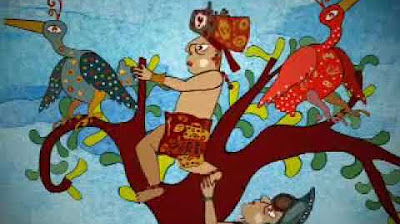El maíz - Centro de Cultura Alimentaria
Summary
TLDRThis script delves into the deep cultural significance of maize in human life, as depicted through the Mayan creation myth where gods molded humans from maize dough, symbolizing the bond between humanity and this vital crop. It emphasizes the poetic beauty of maize, from its roots to its flowers, and its role in sustaining life. The narrative highlights the mutual dependence of maize and humans, where maize requires human intervention to propagate, and humans rely on maize for sustenance and inspiration. The script also touches on the rich culinary and cultural heritage associated with maize, portraying it as a symbol of hope and the foundation of human existence.
Takeaways
- 🌱 The script uses the metaphor of maize to represent the origin and sustenance of human life and knowledge.
- 🌟 It suggests that maize and humans have a symbiotic relationship, with maize being a source of nourishment and poetry, and humans being the cultivators and appreciators of maize.
- 📖 The Mayan mythology is referenced, stating that gods created humans from maize dough to have someone to tell them poetry.
- 🎶 The script describes various cultural practices surrounding maize, including singing, dancing, and praying to it, highlighting its importance in rituals and daily life.
- 🌾 Maize is depicted as a generous provider, offering itself to humans and expecting care and cultivation in return.
- 🌼 The script emphasizes the elegance of the maize flower, suggesting it as the source of poetry and the promise of hope.
- 👫 The evolution of maize and humans is intertwined, with each influencing the other's development.
- 🛠 The importance of human tools and techniques in the cultivation of maize is noted, such as metal seeders, machetes, and different units of measurement.
- 🔄 The script reflects on the process of maize from the field to the table, detailing the stages from harvest to consumption.
- 🏠 The 'house of maize' is presented as a place of hope, constructed by all, and a central part of the culture's food and hope.
- 🇲🇽 The script concludes with an acknowledgment of the Mexican government, possibly in relation to its role in promoting or preserving maize culture.
Q & A
What is the central metaphor mentioned in the script?
-The central metaphor mentioned in the script is the maize plant, which represents the origin and sustenance of human knowledge and life.
How are maize and human beings connected according to the script?
-The script suggests that maize and human beings are interconnected, with maize being a source of food, culture, and poetry, and humans being the caretakers and co-evolvers of maize.
What does the script say about the importance of maize in Mayan culture?
-The script indicates that in Mayan culture, maize is considered sacred, as the gods created humans from maize dough to recite poetry to them.
What is the significance of the maize plant's various stages mentioned in the script?
-The script highlights the importance of the maize plant's stages, from its roots that hold knowledge of the beginning of times, to its tender sprouts, elegant flowers, and the mature cobs that symbolize promise and hope.
What is the role of the human hand in the script's depiction of maize?
-The human hand is depicted as essential for the survival and evolution of maize. It is through human intervention that the maize plant is sown, nurtured, and harvested.
What is the script's perspective on the relationship between maize and poetry?
-The script presents maize as a form of poetry itself, with its growth and cultivation being akin to the creation and recitation of poetry.
How does the script describe the process of maize cultivation?
-The script describes maize cultivation as a multi-step process involving singing, weeding, dancing, grinding, praying, forming, baking, and giving thanks to the maize.
What does the script imply about the necessity of human and maize coexistence?
-The script implies that the coexistence of humans and maize is not just necessary but also enriching, with each party contributing to the other's growth and sustenance.
What is the script's view on the evolution of maize and humans?
-The script suggests that the evolution of maize and humans is intertwined, with the development of one influencing and being influenced by the other.
What cultural significance does the script attribute to the maize plant?
-The script attributes a deep cultural significance to the maize plant, associating it with the foundation of human culture, food, and the spiritual connection to the divine.
How does the script use the metaphor of the house of maize?
-The script uses the metaphor of the house of maize to represent a place inhabited by hope, constructed by all, and symbolizing the cultural and nutritional heritage of maize.
Outlines

Dieser Bereich ist nur für Premium-Benutzer verfügbar. Bitte führen Sie ein Upgrade durch, um auf diesen Abschnitt zuzugreifen.
Upgrade durchführenMindmap

Dieser Bereich ist nur für Premium-Benutzer verfügbar. Bitte führen Sie ein Upgrade durch, um auf diesen Abschnitt zuzugreifen.
Upgrade durchführenKeywords

Dieser Bereich ist nur für Premium-Benutzer verfügbar. Bitte führen Sie ein Upgrade durch, um auf diesen Abschnitt zuzugreifen.
Upgrade durchführenHighlights

Dieser Bereich ist nur für Premium-Benutzer verfügbar. Bitte führen Sie ein Upgrade durch, um auf diesen Abschnitt zuzugreifen.
Upgrade durchführenTranscripts

Dieser Bereich ist nur für Premium-Benutzer verfügbar. Bitte führen Sie ein Upgrade durch, um auf diesen Abschnitt zuzugreifen.
Upgrade durchführenWeitere ähnliche Videos ansehen
5.0 / 5 (0 votes)






